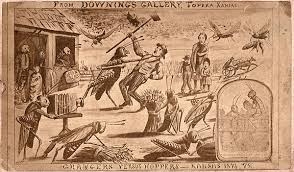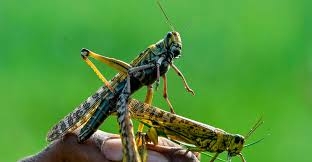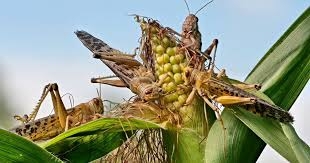The Locusts Who Devoured the Harvest of Nations

The Valley of Plenty was the undisputed breadbasket of the world, a fertile stretch of land that yielded enough bounty to sustain the territories of the Lions, the Tigers, and the vast herds of the Bulls. It was a region of immense, concentrated wealth, carefully nurtured by the long-term policies of the Elephants and protected by the regional armies. But its very abundance made it a target for the most feared force in the land: the Locusts.
These were the Locusts Who Devoured the Harvest of Nations. They symbolized rapid, unsustainable resource exploitation, speculative frenzies, and financial bubbles—entities that appeared suddenly, multiplied exponentially, and were driven by a collective, insatiable hunger. Their power was derived from sheer, overwhelming numbers, speed of deployment, and a total disregard for the long-term viability of the resource. They didn't seek to rule or negotiate; they sought to consume everything in their path before vanishing, leaving behind only economic wasteland.
Their leader, if such a chaotic force could be said to have one, was the abstract concept of Frenzy—a collective, instinctual drive that coordinated the swarm. The Locusts moved as a single, terrifying entity, their millions of wings a drumming chorus of impending doom, their feeding a blur of catastrophic efficiency.

The Economics of Consumption
The Locusts viewed the other creatures as temporary obstacles or, worse, as investments to be harvested. They paid no mind to the slow, bureaucratic movements of the Elephants (international regulatory bodies), knowing that by the time the Elephants formulated a policy, the harvest would be gone. They saw the infighting of the Stallions and the Peacocks as a welcome distraction that gave them more time to feed unnoticed.
Their targets were always concentrated, high-value assets—the Grain Fields (stock markets), the Orchards of Rare Fruit (tech bubbles), and the Irrigation Canals (credit systems). They were experts in identifying and attacking the points where wealth was most dense and most fragile.
The Vultures (financial speculators) held a complex relationship with the Locusts. While the Vultures profited massively from the devastation left behind, they also helped to create the conditions for the swarms, often signaling to the Locusts the precise moment when a harvest was ripe for rapid consumption, or even accelerating the swarm’s development through coordinated, rapid short-selling.
The Cobras and Scorpions (underworld syndicates) both hated and benefited from the swarms. The chaos allowed them to move contraband, but the sudden collapse of a major economy often destabilized their own criminal enterprises.

The Attack on the Golden Maize
The largest, most lucrative crop in the Valley of Plenty was the Golden Maize, a highly valued commodity that was the backbone of several major economies. The fields were vast, carefully tended by the Rabbits (producers), and secured by the Lions (local military). The entire system was regulated by complex, inter-nation contracts signed by the Elephants.
The Locusts had been observed gathering on the western ridges, their numbers growing exponentially, their colors shifting from a camouflage green to the aggressive, yellow hue of a feeding swarm. The local producers sent frantic warnings, but the political leaders were paralyzed by internal squabbles.
The Bulls, who owned the largest share of the Maize, were locked in a debate with the Tigers over a minor trade tariff. The Elephants were mired in a procedural discussion about whether to classify the gathering swarm as a "market anomaly" or an "act of aggression"—a vital distinction for releasing emergency funds.
The Locusts struck not with military precision, but with the speed of a technological flash crash. The swarm descended in a massive, dark cloud, blotting out the sun.
Their consumption was total. They didn't eat just the maize kernels; they devoured the stalks, the leaves, and even gnawed at the exposed roots, ensuring that the fields would not yield a crop for seasons to come.

The Regulatory Paralysis
The Lions' defense forces were utterly helpless. They were trained to fight organized enemies—Tigers, Stallions—not a decentralized, biological phenomenon. Their weapons were designed to destroy, but the Locusts’ sheer number and speed meant that for every thousand killed, ten thousand more landed. The Lions' attempts to quarantine the fields only delayed their own eventual consumption.
The Foxes (politicians and lobbyists) fled the scene, their smooth talk useless against the drumming of wings. The Hedgehogs (isolationists), who had burrowed deep, were safe physically, but their small reserves would eventually be overwhelmed by the widespread famine.
The Elephant Delegation, finally passing their resolution, arrived at the Valley only to find a landscape of shredded stalks and bare earth. The devastation was complete.
Their chief economist, an old, wrinkled Elephant, surveyed the destruction and sighed. "We passed the emergency sanction just as the consumption peaked. The rules arrived too late to stop the extraction, and now the resources for our rescue package are gone."
The Locusts, having consumed every bit of energy in the fields, didn't stay to enjoy their victory. Their Frenzy directed them onward, a smaller, leaner, but still potent swarm, moving rapidly toward the next patch of dense, concentrated wealth: the River Crossing Conduits (infrastructure bonds) controlled by the Crocodiles.

The Aftermath of Frenzy
The Valley of Plenty was silent. The Rabbits and Bulls were ruined, staring at a season of famine. The Crows (news media) circled, their reports filled with shocking images of devastation, but offering no real explanation of why the established order had failed to stop the inevitable.
The Vultures, now arriving in force, began their work. They consumed the weakened assets, buying up the fallow land from the desperate Bulls and Rabbits for pennies on the dollar. The crisis, which ruined the producers, became a spectacular opportunity for the financiers.
In the midst of the desolation, a small, weary contingent of Owls (technical advisors) found a surviving Rabbit elder. The Owl asked, "Why did you not anticipate this? The swarms gather every generation."
The Rabbit looked at the bare earth. "We knew the Locusts would come. We just hoped the Lions would fight the threat, or the Elephants would regulate the sky, or the Bulls would agree on the defense budget. We spent all our time waiting for the powerful to protect the harvest, and so, we were too busy producing to protect ourselves."
The Locusts, now far away, were a symbol of a brutal, simple truth: When the powerful are distracted by procedure and internal conflict, and when wealth is left dense and unprotected, a sudden, collective frenzy will always appear to consume the profits of nations. The only real defense against the inevitable swarm is collective vigilance and a refusal to allow the harvest to grow so dense that its very existence becomes the ultimate, irresistible lure.
- Questions and Answers
- Opinion
- Motivational and Inspiring Story
- Technology
- Live and Let live
- Focus
- Geopolitics
- Military-Arms/Equipment
- Securitate
- Economy
- Beasts of Nations
- Machine Tools-The “Mother Industry”
- Art
- Causes
- Crafts
- Dance
- Drinks
- Film/Movie
- Fitness
- Food
- Jocuri
- Gardening
- Health
- Home
- Literature
- Music
- Networking
- Alte
- Party
- Religion
- Shopping
- Sports
- Theater
- Health and Wellness
- News
- Culture

